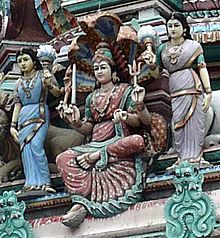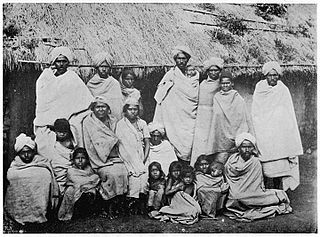
The Badagas are an ethno-linguistic community living in the Nilgiri district in Tamil Nadu, India. Throughout the district the Badugas live in nearly 400 villages, called Hattis. The Badagas speak a language called Badaga.
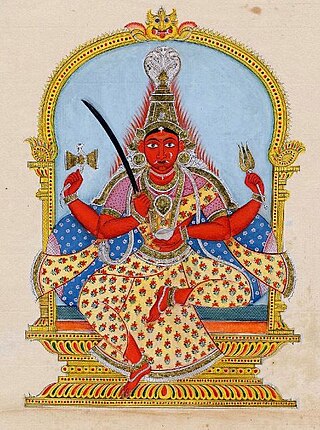
Mariamman, often abbreviated to Amman, is a Hindu goddess of weather, predominantly venerated in the rural areas of South India. Her festivals are held during the late summer/early autumn season of Ādi throughout Tamil Nadu and the Deccan region, the largest being the Ādi Thiruviḻa. Her worship mainly focuses on bringing rains and curing diseases like cholera, smallpox, and chicken pox. Mariamman is worshipped in accordance with local traditions such as Pidari or the Gramadevatai. She is considered as a guardian deity by many South Indian village-dwellers.

The Sri Mariamman Temple is Singapore's oldest Hindu temple. It is an agamic temple, built in the Dravidian style. Located at 244 South Bridge Road, in the downtown Chinatown district, the temple serves the majority Hindu Singaporeans, Tamilians, in the city-state. Due to its architectural and historical significance, the temple has been gazetted a National Monument and is a major tourist attraction. Sri Mariamman Temple is managed by the Hindu Endowments Board, a statutory board under the Ministry of Community Development, Youth and Sports.
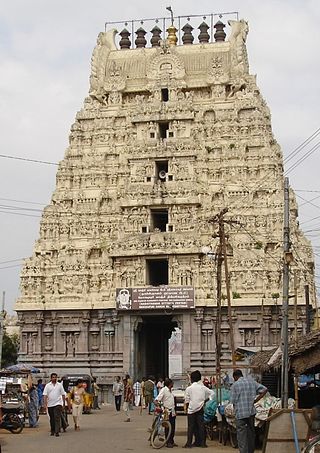
The Sri Kamakshi Amman Temple is an ancient Hindu Temple dedicated to the goddess Kamakshi, one of the highest aspects of Adi Parashakti, the mighty goddess in Shaktism. The temple is located in the historic city of Kanchipuram, near Chennai, India. The temple houses one of the 108 Divya Desams of Vishnu and is called Tirukalavanur. The temple is dedicated mainly to Kamakshi and then to Vishnu in his form of Varaha. The temple is glorified by the 6th-9th century Vaishnavite Alvars in the Naalayira Divya Prabandham. Its construction is credited to the Pallava kings, whose capital was in the same city. This temple, along with the goddesses of Madurai and either Varanasi or Thiruvanaikovil, are the important centers of Shaktism in the state of Tamil Nadu. The present temple is also known as Kamakoti Peetha or Kamakota Nayaki Kovil, where Tripura Sundari had settled after killing a demon. This ancient temple was mentioned in Perunaraatrupadai, an ancient Tamil literature that praises the renowned Sangam era. King Thondaiman Ilandiraiyan of the Pallava dynasty, who ruled Kanchipuram, constructed the temple. Kamakshi is worshipped in the shrine in 5 forms, one of them was a golden idol, which was transported to Thanjavur due to the Muslim invasions of Kanchipuram. There are no other goddess temples in the city of Kanchipuram, apart from this one, which is unusual in a city that has hundreds of traditional temples. There are various legends that account for this fact.

The Arulmigu Sri Mahamariamman Temple is a Hindu temple within George Town in the Malaysian state of Penang. The oldest Hindu temple in the state, it was built in 1833, and features sculptures of gods and goddesses over its main entrance and facade.

Arulmigu Sri Mariamman Temple, Samayapuram is an ancient Hindu temple in Tiruchirappalli district in Tamil Nadu, India. The main deity, Samayapurathal or Mariamman, a form of Adi Parashakti, is made of sand and clay with extractions of medicinal herbs unlike many of the traditional stone idols and is considered as most powerful Goddess, and hence unlike many other Hindu deities there are no abhishekams conducted to the main deity, but instead the "abishekam" is done to the small stone statue in front of it.

The village deities of Southern India are the numerous spirits and other beings venerated as part of the Dravidian folk tradition in villages throughout South India. These deities, mainly goddesses, are intimately associated with the well-being of the village, and can have either benevolent or violent tendencies. These deities are presently in various stages of syncretism or assimilation with mainstream Hindu traditions.

The Thimithi or firewalking ceremony is a Hindu festival originating in Tamil Nadu, South India that is celebrated a week before Deepavali, during the month of Aipasi of the Tamil calendar. The fire-walking ceremony is in honour of the goddess Draupati Amman, who is considered the incarnation of goddess Mariamman, and is practiced not only in India, but also in countries with large Tamil populations like Sri Lanka, Fiji, Singapore, Malaysia, Mauritius, Réunion, South Africa and others.

Sri Maha Mariamman Temple, also known as Maha Uma Devi Temple (Thai: วัดพระศรีมหาอุมาเทวี; RTGS: Wat Phra Si Maha Umathewi and Wat Khaek in Thai, is a South Indian architecture style Hindu temple on Si Lom Road in Bangkok, Thailand. It was built in 1879 by Vaithi Padayatchi, a Tamil Hindu immigrant.

Bannari Amman temple is an Amman temple in the Indian state of Tamil Nadu. It is located near Sathyamangalam, Erode district.
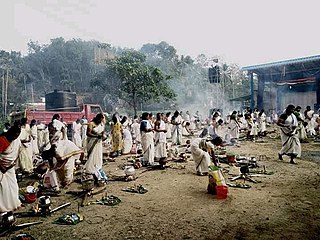
Pongala is a harvest festival of Kerala and Tamil Nadu. The name 'Pongala' means 'to boil over' and refers to the ritualistic offering of porridge made of rice, sweet brown molasses, coconut gratings, nuts and raisins. Generally women devotees participate in this ritual. Tamil people celebrate as Pongal.
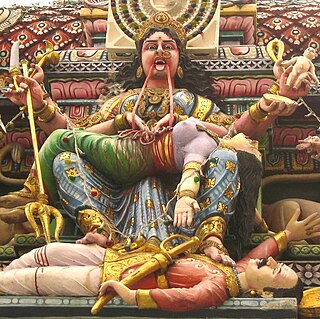
Periyachi is a ferocious aspect of Parvati in Hinduism. She is also known as Periyachi Amman and sometimes called as Periyachi Kali Amman as she is associated with the goddess Kali. According to some accounts, the deity is a Guardian form of the Mother Goddess, who is prayed to in order to prevent misfortune during childbirth. Periyachi is said to be the protector of children, and is associated with childbirth and pregnancy, and is a deity revered in Singapore, The Caribbean, Malaysia and Réunion Island.

Green fields is a suburb in Ooty town in the Tamil Nadu state of India. It constitutes ward no. 9 of the Ooty constituency of Tamil Nadu.

Ooty lake is an artificial lake near Ooty in the Nilgiris district of Tamil Nadu, India. It covers an area of 26 hectares. The boathouse on the lake is a major tourist attraction.

The Kamaraj Sagar Dam is in the Nilgiris district of Tamil Nadu state in India. It is located at a distance of 10 km from the Ooty bus stand. It is a picnic spot and a film shooting spot on the slopes of the Wenlock Downs. The dam's storage capacity is 26.6 million cubic meters(MCM) or 0.94 tmc ft.
The flower festival or flower sprinkling festival is an important festival celebrated in the Samayapuram Mariamman temple near Tiruchirappalli, India. This festival is usually held in the Tamil month of Masi. During this festival, devotees throng the temple to sprinkle flowers on the idol of the Hindu goddess Mariamman. During this period, it is believed, that the goddess fasts for the welfare of her devotees for a period of 28 days. As a result, the ritual consecration of food at the temple does not take place.

Charring cross is a junction in National Highway 67 (India) intersecting the commercial road and the Ooty-Coonoor road in Ooty, Tamil Nadu. It is considered to be one of the most important and beautiful places in Ooty. The important landmark in charring cross is the Gandhi Statue.
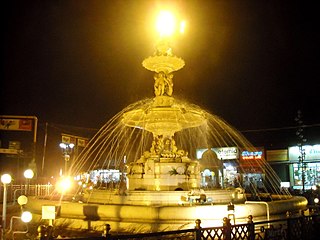
Adam's fountain is a public display fountain in Charring cross, Ooty. It was built in 1886 as a memorial to a Governor of Ooty, who was very famous in the region during his tenure. The total cost of finishing the fountain was between Rs. 13,000 to Rs. 14000, which was funded through public funding.
Gori shola is a locale in Ooty famous for its water reservoir. It is located off the road from Ooty to Doddabetta amidst the Doddabetta forests. It is a tourist spot in the town, which provides a pleasing look of the surroundings from the top of the reservoir.
Muthumariamman Temple is situated at Narthamalai in Pudukkottai district in Tamil Nadu, India.
